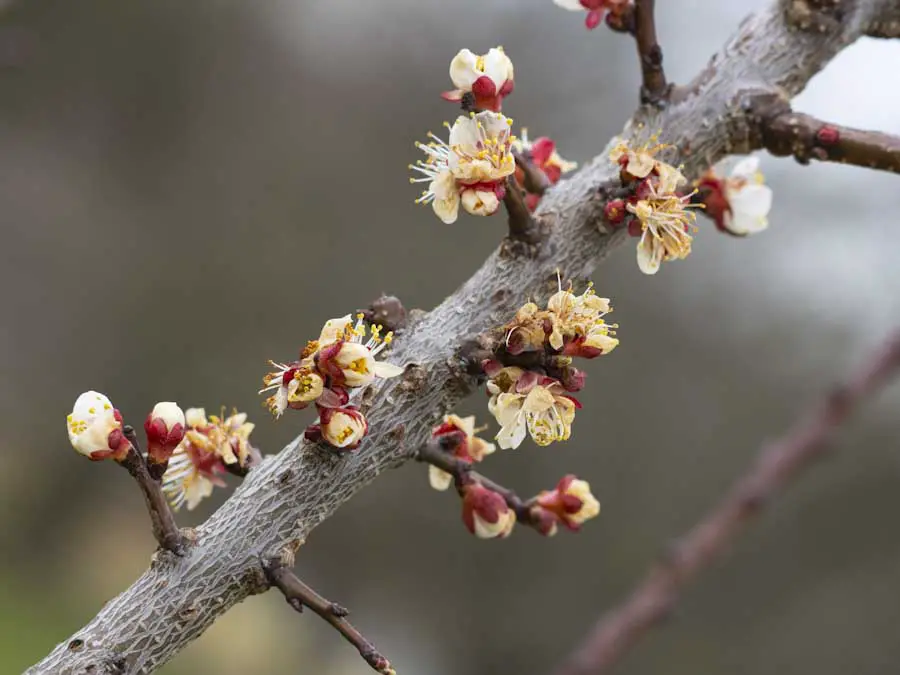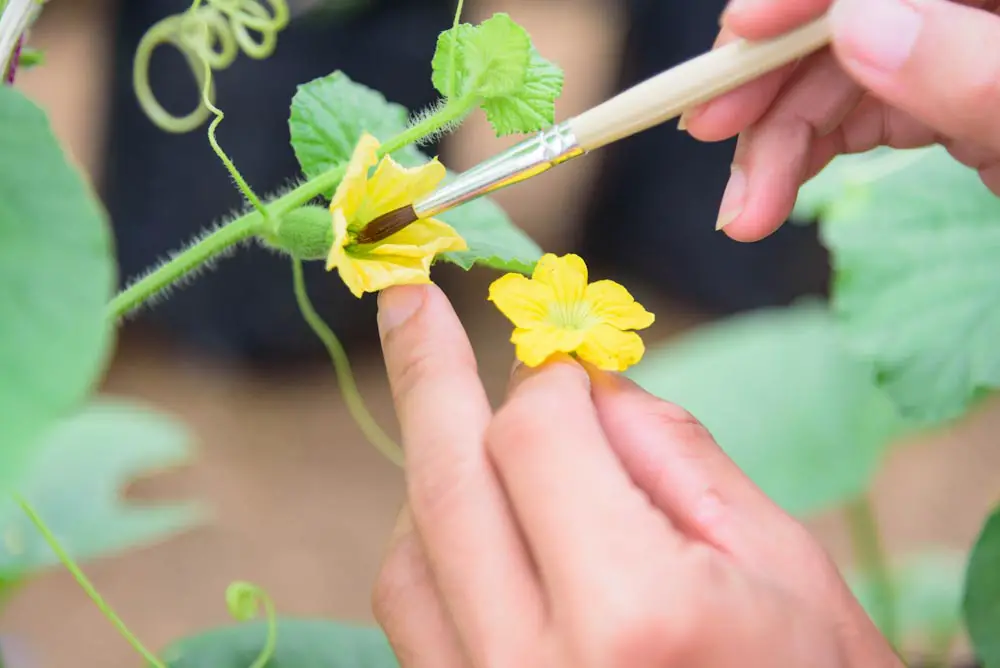
Whenever I consider adding a new fruit tree to my garden, this is the first question I ask: Am I adding just one tree, or does there need to be a second tree for pollination? It’s an important question for a home gardener, where space may be at a premium and every inch of garden space counts.
Pollination is especially important to consider if you are planting an apricot tree. Apricot trees are notoriously inconsistent in their fruiting habits, and a lack of pollination is one of the reasons an apricot tree might not produce a crop one year. (To learn about other reasons, check out my article: Fruitless Apricot Tree? These 10 Things May Be to Blame.)
Most apricot trees are self-pollinating, so only one tree is needed to bear fruit. However, self-pollinating cultivars will have a better crop if another apricot tree is nearby. Some apricot varieties are self-sterile or partially self-fertile, so they do need to be cross-pollinated.
The short answer is that you probably only need one apricot tree…but there’s more to it than that. Read on to learn all about apricot pollination – how they are pollinated, how to improve pollination, how close to plant cross-pollinating trees, and even how to hand-pollinate an apricot tree.
Apricot Tree Pollination Basics
Are apricots self-pollinating?
Apricot trees are typically self-fertile, so they can be pollinated from flowers on the same tree. There are a few exceptions that do need cross-pollination by another apricot cultivar. However, even self-pollinating apricot trees will have increased fruit set and less fruit drop with a pollination partner nearby.

Cross pollination occurs when a pollinator carries pollen from a flower on one tree to a flower on another tree. Self-pollinating trees can set fruit if pollen is transferred from one blossom to another on the same tree. With apricots, pollination from another apricot variety improves the chances of fruit set.
Just about any apricot tree will cross-pollinate with any other, as long as their blooms are open at the same time. Most apricot trees bloom in the early spring, but there is some difference in when exactly the blossoms are open. Bloom time can also vary depending on the climate and the weather. When in doubt, ask for apricot variety recommendations from a local nursery or your nearby extension service.
It’s important to note that even though other stone fruits are related to apricots (plum, peach, cherry, etc.), they will not cross-pollinate with apricot trees. Two different apricot varieties are needed for pollination. Some hybrid apricot trees, such as ‘Flavor Delight’ and ‘Cot-N-Candy’ apriums, can also be apricot pollinizers.
How are apricots pollinated?
Apricot tree buds begin to form in the fall, but the blossoms open in early spring when the tree emerges from dormancy. Every apricot tree produces “perfect” flowers, meaning they contain both male and female parts.

Once the apricot blooms are fully open, pollinators will transfer pollen from one of the roughly 30 male stamens of one flower to the sticky female stigma (or pistil) of another flower. Or, in the case of trees that need cross-pollination, the pollen will be brought from the blossoms of one tree to another.
The little granules of pollen will then germinate and travel down the stigma to fertilize the ovary at the base of the blossom. This fertilization is what starts fruit development.
Apricot blossoms are receptive to pollen for only about 24 to 48 hours, when they are fully open. Some trees bloom gradually, with the flowers opening over a period of weeks. Other trees have relatively short bloom times, perhaps for several days.
Learn more: When Do Apricot Trees Flower? Best Varieties by Bloom Time

An apricot tree’s bloom time is also affected by the weather. An extra cold winter may lead the tree to blossom all at once. A winter with fewer chill hours will cause the blossoms to open more gradually. Hotter weather will also shorten the amount of time that a blossom is fully open and receptive to pollination.
How far apart should apricot pollination partners be?
Plant cross-pollinating apricot trees less than 50 feet apart for the best chance at pollination. They can be pollinated at greater distances, but the farther the pollinators have to travel, the smaller the crop is likely to be.
Which apricot varieties need a second tree for pollination?
The following list is not exhaustive, but includes some of the most common self-sterile apricot varieties that need to be pollinated by another tree.
Some of the varieties listed may be partially self-fertile in some climates and locations, but completely self-sterile in others. It’s typical for apricot trees growing in colder climates to need a pollination partner, but the same variety could be self-fertile in a warmer climate.
Where possible, I’ve included suggested pollination partners for each variety. There are many more possible pollinizers than those listed. The primary requirement when choosing an apricot pollinizer is that they bloom at the same time. Choosing two trees that bloom at the same time, but fruit at different times, will extend your apricot harvest.

These apricot cultivars are typically self-sterile (suggested pollinizers follow each variety):
- ‘Harlayne’ – ‘Harcot’, ‘Hargrand’, ‘Harogem’
- ‘Rival‘ – ‘Goldrich’, ‘Perfection’, ‘Moorpark’
- ‘Vivagold‘ – ‘Goldcot’
- ‘Perfection‘ – ‘Goldcot’, ‘Robada’, ‘Rival’
- ‘Orange Red‘ – ‘Robada’, ‘Tomcot’
- ‘Bebeco‘ (partially self-fertile)
- ‘Wonder Cot‘ – ‘Tomcot’, ‘Magic Cot’, ‘Lilly Cot’
- ‘Sungold‘ – ‘Moorpark’, ‘Moongold’, ‘Debbie’s Gold’
- ‘Tomcot‘ (partially self-fertile) – ‘Golden Sweet’, ‘Orange Red’
- ‘Goldbar‘ (partially self-fertile) – ‘Goldstrike’
- ‘Goldrich‘ – ‘Moorpark’, ‘Rival’
Encouraging Apricot Tree Pollinators
Apricot tree pollinators include honey bees, wasps, butterflies, birds, and some flies. But since bees are less active in the early spring (when apricot trees blossom), due to the wet and cool weather, pollination can be inconsistent.
There are a few things that can encourage pollinators to hang around an apricot tree. It’s a good idea to plant some pollinator-friendly companion flowers nearby to draw bees and butterflies in. Some early-blooming flowers include heather, lavender, bleeding heart, lilac, and grape hyacinth.

However, apricot blossoms are not necessarily as appealing as other flowers, due to a lower concentration of sugar in the nectar. So plant some flowers nearby, but don’t overfill the vicinity with companion plants.
You can also hang a bird feeder in the tree itself to encourage birds to visit and carry pollen from flower to flower as they seek out the nectar. Hummingbirds (and other small birds) are the most likely pollinators of fruit trees, so try hanging a hummingbird feeder from one of the branches.
I would recommend, however, moving the feeder somewhere else once the baby fruits emerge. You may be willing to share pollen with the birds, but you don’t want to encourage them to feast on the fruit.
Another tip is to keep blooming weeds away from the base of the tree. You want pollinators to want the apricot nectar, not the potentially more enticing flowering weeds. The goal is to draw pollinators to the area, but not detract from the appeal of the apricot blossoms.
Things that Prevent Apricot Tree Pollination
The pollination of apricot blossoms can be prevented or diminished by both environmental and cultural factors, such as climate, weather, and pesticide application. Here are some reasons an apricot tree may not be pollinated:

- Late frost damage. A hard frost late in the spring, once the blossoms have opened, can damage or kill the tender blooms. Even if the apricot blossoms look ok after a freeze, their reproductive capabilities may not have survived. Some frost-damaged blossoms can’t be fertilized even if a pollinator visits.
- Excessive heat. If the temperatures rise too quickly in spring, pollinators may stay closer to their home. Bees tend to like warm, sunny temperatures, but unseasonably hot weather may affect the quality and quantity of the nectar, making pollination more challenging. Higher temperatures also reduce the blossoms’ receptive time (the amount of time they are fully opened and ready to be pollinated).
- Excessive rain or wind. Wind and rain can keep bees and other pollinators from flying around, reducing pollination. Wind does help with pollination, but bees are far more effective. Heavy spring rain can also damage the fragile apricot blossoms.
- Long cold spells. Bees prefer warmer weather, so prolonged cold temperatures in the early spring may keep the bees at home. At temperatures below 50-55°F, bees are unlikely to fly far from their hives.
- Pesticides. Avoid spraying any and all pesticides while an apricot tree is in bloom, to keep from harming bees and other pollinators.
Can you pollinate apricot blossoms by hand?
If there is an extended period of wet and windy weather in the forecast, it may be time for manual pollination. Those apricot blossoms will only be receptive for a small amount of time, so if weather conditions are keeping pollinators from buzzing around, you may need to intervene.

Pollinate apricot blossoms by hand only as a last resort. There’s a greater chance that the delicate flowers will be damaged by even a careful hand. Nature is by far the best chance at pollination, but sometimes we can help nature along.
How to Manually Pollinate Apricot Blossoms
To hand-pollinate apricot trees, use a small soft paintbrush or cotton swab. Locate the tiny yellow sacs of pollen (anthers) at the end of the long filaments in the center of the flower. Gently sweep the brush or swab across to collect some pollen. Immediately brush the center of another flower.
Since apricot blossoms are “perfect,” you don’t have to worry about which flowers are male and which are female. Just be as light-handed as possible to avoid damaging the flowers. Hand-pollinate when the blossoms are completely open.

